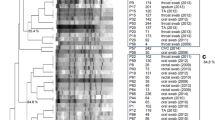Abstract
The incidence of fungal infections, in particular candidiasis and aspergillosis, has considerably increased during the last three decades. This is mainly due to advances in medical treatments and technologies. In high risk patients (e.g. in haematology or intensive care), the prognosis of invasive candidiasis is relatively poor. Therefore, a rapid and correct identification of the infectious agent is important for an efficient and prompt therapy. Most clinical laboratories rely on conventional identification methods that are based on morphological, physiological and nutritional characteristics. However, these have their limitations because they are time-consuming and not always very accurate. Moreover, molecular methods may be required to determine the genetic relationship between the infectious strains, for instance in Candida outbreaks. In addition, the latter methods require time, expensive consumables and highly trained staff to be performed adequately. In this study, we have applied the FTIR spectroscopic approach to different situations encountered in routine mycological diagnosis. We show the potentials of this phenotypic approach, used in parallel with routine identification methods, for the differentiation of 3 frequently encountered Candida species (C. albicans, C. glabrata and C. krusei) by using both suspensions and microcolonies. This approach, developed for an early discrimination, may help in the initial choice of antifungal treatment. Furthermore, we demonstrate the feasibility of the method for intraspecies comparison (typing) of 3 Candida species (C. albicans, C. glabrata and C. parapsilosis), particularly when an outbreak is suspected.





Similar content being viewed by others
References
Sims CR, Ostrosky-Zeichner L, Rex JH (2005) Arch Med Res 36:660–671
Ruhnke M (2006) Curr Drug Targets 7:495–504
Fidel PL Jr, Vazquez JA, Sobel JD (1999) Clin Microbiol Rev 12:80–96
Murray PR, Baron EJ, Pfaller MA, Tenover FC, Yolken RH (eds) (1999) Manual of clinical microbiology, 7th edn. ASM Press, Washington
Maquelin K, Kirschner C, Choo-Smith LP, Ngo-Thi NA, Van Vreeswijk T, Stammler M, Endtz HP, Bruining HA, Naumann D, Puppels GJ (2003) J Clin Microbiol 41:324–329
Del Castillo L, Bikandi J, Nieto A, Quindós G, Sentandreu R, Pontón J (1997) Mycoses 40:445–450
Pfaller MA (2001) Emerg Infect Dis 7:312–318
Sakallah SA (2000) Biotechnol Annu Rev 6:141–161
Williams DW, Wilson MJ, Lewis MAO, Potts AJ (1995) J Clin Microbiol 33:2476–2479
Senses-Ergul S, Agoston R, Belak A, Deak T (2006) Int J Food Microbiol 108:120–124
Plachy R, Hamal P, Raclavsky V (2005) J Microbiol Methods 60:107–113
Rozynek P, Gilges S, Brüning T, Wilhelm M (2004) Int J Hyg Environ Health 207:297–299
Nazzal D, Yasin S, Abu-Elteen K (2005) New Microbiol 28:245–250
Fischer G, Dott W (2002) Int J Hyg Environ Health 205:433–442
Naumann D, Helm D, Labischinski H (1991) Nature 351:81–82
Timmins EM, Howell SA, Alsberg BK, Noble WC, Goodacre R (1998) J Clin Microbiol 36:367–374
Schmalreck AF, Trankle P, Vanca E, Blaschke-Hellmessen R (1998) Mycoses 41:71–77
Orsini F, Ami D, Villa AM, Sala G, Bellotti MG, Doglia SM (2000) J Microbiol Methods 42:17–27
Sockalingum GD, Bouhedja W, Pina P, Allouch P, Mandray C, Labia R, Millot JM, Manfait M (1997) Biochem Biophys Res Com 232:240–246
Sandt C, Sockalingum GD, Aubert D, Lepan H, Lépousé C, Jaussaud M, Léon A, Pinon JM, Manfait M, Toubas D (2003) J Clin Microbiol 41:954–959
Essendoubi M, Toubas D, Bouzaggou M, Pinon JM, Manfait M, Sockalingum GD (2005) Biochim Biophys Acta 1724:239–247
Ward JH, Hierarchical grouping to optimise an objective function (1963) J Am Stat Assoc 58:236–244
OPUS/IDENT (1996) Reference manual. Autorenkollektiv, Ettlingen, Germany
Nedret Koc A, Kocagoz S, Erdem F, Gunduz Z (2002) Mycoses 45:470–475
Clark TA, Slavinski SA, Morgan J, Lott T, Arthington-Skaggs BA, Brandt ME, Webb RM, Currier M, Flowers RH, Fridkin SK, Hajjeh RA (2004) J Clin Microbiol 42:4468–4472
Adt I, Toubas D, Pinon JM, Manfait M, Sockalingum GD (2006) Arch Microbiol 185:277–285
Kummerle M, Scherer S, Seiler H (1998) Appl Environ Microbiol 64:2207–2214
Fischer G, Braun S, Thissen R, Dott W (2006) J Microbiol Methods 64:63–77
Wenning M, Seiler H, Scherere S (2002) Appl Environ Microbiol 68:4717–4721
Acknowledgements
The authors thank Pfizer Laboratories for supporting this work.
Author information
Authors and Affiliations
Corresponding author
Rights and permissions
About this article
Cite this article
Toubas, D., Essendoubi, M., Adt, I. et al. FTIR spectroscopy in medical mycology: applications to the differentiation and typing of Candida . Anal Bioanal Chem 387, 1729–1737 (2007). https://doi.org/10.1007/s00216-006-1005-1
Received:
Revised:
Accepted:
Published:
Issue Date:
DOI: https://doi.org/10.1007/s00216-006-1005-1




